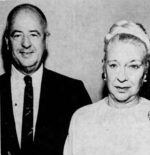PART 2 of 2
Music was not the only creative outlet for Herb Taylor. At the same time he was arranging music for composer Dimitri Tiomkin, he and his wife June were perfecting a home recipe for a cocktail sauce that got high praise when shared with friends.
The founding of Taylor Food Hobbies in 1953 and incorporation of Taylor Food Products in 1961, officialized a mom and pop (and son) business that created three tomato-based products sold to consumers under the brand name of Mr and Mrs “T”®. First, a Cocktail Barbeque Sauce, followed by a Marinade, and then a Bloody Mary Mix. Today a full line of Mr & Mrs T® cocktail mixes are sold by Keurig Dr Pepper.
Taylor Food Hobbies
“It started off as a hobby. It was a fun thing for my folks, and we all enjoyed it.” That’s how son Lee Taylor remembers the family-run business. “But I don’t think anybody ever thought it would grow like this,” he said in 1983, referring to the 1.5 million cases of Mr & Mrs “T” Bloody Mary Mix the company was shipping nationwide and overseas.
Taylor Food Hobbies represented a business that started as a leisurely extra-curricular activity. The company’s first product, branded as Taylor’s Cocktail Barbecue Sauce, went into use on August 11, 1953, according to paperwork filed later that year with the U.S. Patent Office.
The product was produced in the kitchen of Herb and June Taylor located two blocks from Fox Studios adjacent to present-day Century City. The family had moved to 10310 Keswick Avenue from a home in Beverly Grove during World War II. In 1950, while June Taylor was sharing samples of her cocktail barbecue sauce with friends and selling some out of their home, and, later, through a neighborhood liquor store on nearby Pico Boulevard, husband Herb was at work with Tiomkin on a “Masterful Score for ‘Cyrano de Bergerac.’” As sales of the sauce grew, the operation would move out of the family home and into a factory in Van Nuys, California.
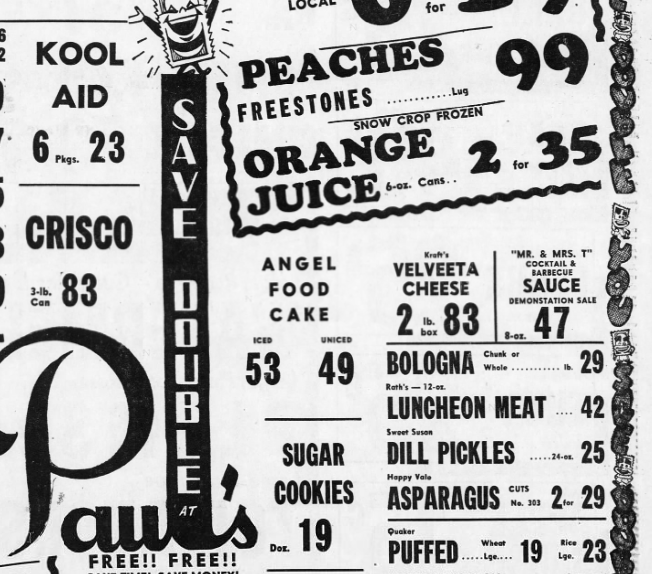
The Mr. & Mrs. T® branding came early, as seen in a July 1954 print ad for the “Cocktail & Barbecue” sauce for a demonstration at Paul’s Markets, a neighborhood meat and supermarket in San Bernadino. June Taylor returned to Paul’s in August for another demonstration sale of the sauce with cocktail party snacks. At “Tast-N-Tell!” shoppers could pick up 8-ounce bottles and 2-ounce samplers.
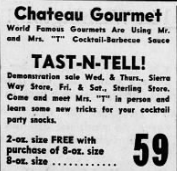
Another early public glimpse of the product came in 1956, when Herb and June Taylor, referred to as “food hobbyists,” introduce the new sauce to the public in Bakersfield. Herb remained at his day job, furnishing orchestrations for two films with music by Tiomkin, Giant and Friendly Persuasion, in theaters around the country.
Appearing at the Mayfair Market, the couple would demonstrate, “Mr. and Mrs. T Cocktail Barbecue Sauce and Dunk,” a versatile sauce that could be served hot or cold and used as a flavoring for meat, poultry, or seafood. Dunked items might include hot dogs, cocktail sausages, or shrimp. Recipes suggested mixing the sauce with other ingredients to make Clam Dip or Cheese Spread.
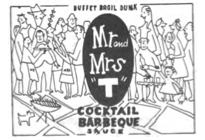 A Keswick Avenue neighbor of the Taylors had a nephew in the art department at the Los Angeles Times and he designed the label born after studio musicians sampled the sauce and encouraged the couple to put a label on it. Misaligned white letters within a black oval are surrounded by human silhouette figures, a barbeque, and a dog. The label text reads, BUFFET BROIL DUNK / Mr and Mrs “T” / COCKTAIL BARBEQUE SAUCE.
A Keswick Avenue neighbor of the Taylors had a nephew in the art department at the Los Angeles Times and he designed the label born after studio musicians sampled the sauce and encouraged the couple to put a label on it. Misaligned white letters within a black oval are surrounded by human silhouette figures, a barbeque, and a dog. The label text reads, BUFFET BROIL DUNK / Mr and Mrs “T” / COCKTAIL BARBEQUE SAUCE.
Lee Taylor attributes the recipe for the barbecue sauce to his grandmother, Margaret E. Gofield, June’s mother. Margaret was a Stockton native; however, her mother, Ella Jane (Lewallen) Stevenson, was born in Kentucky and lived in Missouri before moving to California. If the family recipe was handed down from Margaret’s mother that might account for some Midwestern flavor.
A second, similar sauce, Mr. & Mrs. “T” Marinade, was bottled in 8 fluid ounce containers for shrimp, roast, and chops and sold in markets alongside Macaroon Munchettes and Coconut Mounds. (In 1984, Mr. and Mrs. “T” would add a Cream of Coconut Mix to its product line.)
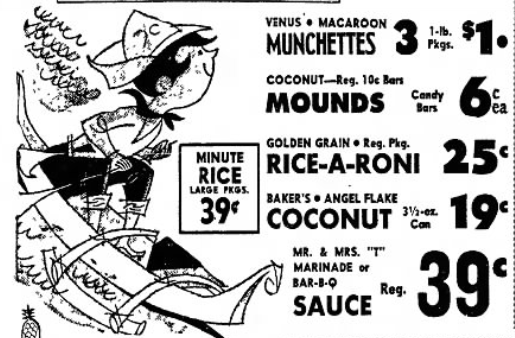 Excerpt of print ad, Van Nuys News, June 18, 1959
Excerpt of print ad, Van Nuys News, June 18, 1959
Bloody Mary, what art thou?
The origin of the Bloody Mary is muddled. Let’s sidestep the conflicting creation and naming stories and embrace the fact that by the time the 1930s were history the Bloody Mary was being touted as a hangover cure in the United States. As Lee Taylor would later posit, “We took it out of the hangover category and turned it into a legitimate drink.”
“Vodka was virtually unknown” in the U.S. prior to World War II and was not widely consumed here until the mid-1950s, when the Bloody Mary, the Screwdriver, and the Moscow Mule became wildly popular. “Vodka is different from every other alcoholic beverage. While the distillers, rectifiers and blenders of all other spirits strive to give their products a sharply distinctive taste, smell and color, the vodka manufacturer aims for absolute neutrality.” The key to purification is activated charcoal. Smirnoff Vodka is filtered nine times for smoothness and a 1960 newspaper ad claimed “The bloody mary took on historic proportions the first time it was made with Smirnoff.”
Contrarily, “In most classic cocktails, the star ingredient is the liquor,” writes Katie Aberbach in the Washington Post; however, with the Bloody Mary when mixed with vodka the non-alcoholic flavors shine. Whether it really is a cure for a hangover or just an excuse to drink after the sun rises, the non-alcoholic essentials are tomato juice, Worcestershire sauce, lemon juice, salt, black pepper, and Cayenne pepper. A celery stalk is the most common garnish. To spike the spiciness, non-traditionalists might opt for hot sauce, Busha Browne’s Pukka Hot Pepper Sauce, horseradish, and assorted other spices. At one time, the Tabasco company made its own brand. McClure’s Bloody Mary Mixer incorporates pickle juice.
Purists should note the original proportions may have been half and half, two ounces of vodka to two ounces of tomato juice, which is why a homemade cocktail is best served in a five-ounce sour glass, shaken with chopped ice, and strained. Lemon juice adds acidity—lemons are more acidic than tomatoes—and generally blends better with tomatoes than limes. Today, the pH of Mr & Mrs T® Bloody Mary Mix is 3.1, which is moderately acidic, akin to black coffee.
Actor George Jessel talked up the beverage in the early 1940s and fellow comedian and actor George Burns swore by it, he drank one daily, often when lunching at the Hillcrest Country Club in mid-city L.A. In mass media, the Bloody Mary would be featured prominently on the tv sitcom The Jeffersons, and in movies, including The First Wives Club, The Royal Tenenbaums, and Bridget Jones’s Diary. Simultaneously with the introduction of the Taylor’s Bloody Mary Mix, in Ian Fleming’s novel Thunderball, published in 1961, when agent 007 James Bond meets up with Dominetta Vitali (in the screen version four years later “Domino” would be played by Claudine Auger), she orders a double Bloody Mary, “with plenty of Worcester sauce,” at “exactly midday.” When the drink arrives, Dominetta stirs it with her finger “to mix in the brown sediment of Worcester sauce,” and downs half of it.
In the podcast, “The Art of Drinking,” Episode 21 on the Bloody Mary, listeners learn there are “no rules” other than vodka and tomatoes, it’s the perfect Super Bowl party cocktail, the present-day recommended ratio is three-to-one, and you should try it with gin.
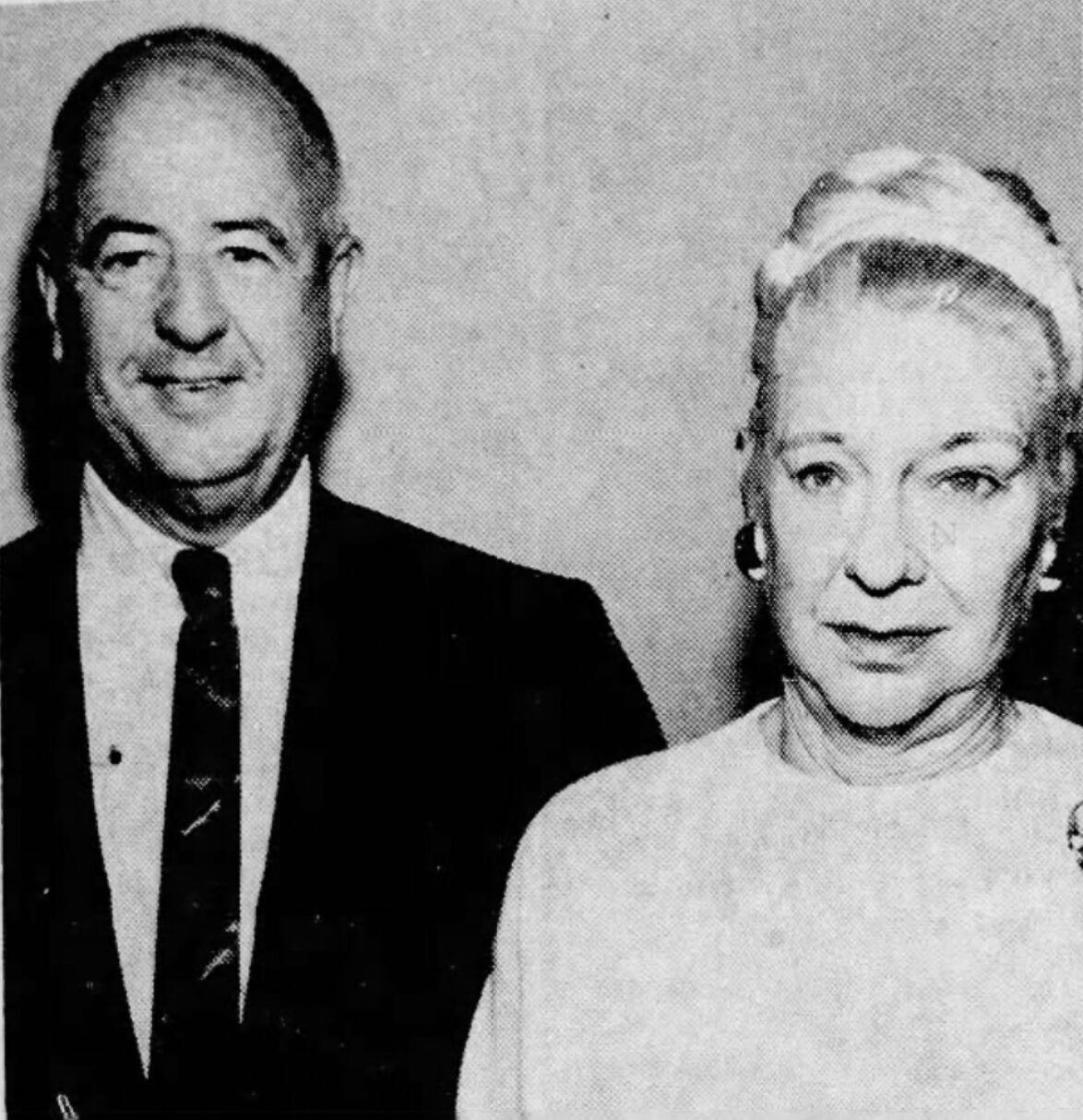 Team Taylor
Team Taylor
“They were a team,” Lee Taylor remembers of his parents. From partying to grocery shopping “they were always together” and promoting or supporting each other.
June Taylor enjoyed a good Bloody Mary; however, the inconsistent nature of the drink when ordered at bars and in restaurants left her wanting.
In the 1960s, a Bloody Mary was typically made by mixing vodka with tomato juice or V-8 juice (blended tomatoes, beets, carrots, celery, lettuce, parsley, spinach, and watercress), the latter still a viable option. The influential New York Times Cook Book, edited by Craig Claiborne and first published in 1961, called for one part vodka to two parts tomato juice with lemon juice, Worcestershire sauce, salt, and pepper.
Spicy tomato juice, sold by both Dole and Del Monte, and a “Tomato Juice Party Drink,” basically a non-alcoholic Bloody Mary, hit the patio party and home entertaining circuit and were trending in the mid- and late-1950s. The drink was served warm during the winter holidays. Curiously, the recipe for a “new beverage,” a “spicy tomato juice,” served from 7-ounce bottles was widely-distributed in January 1961 to newspapers via United Press International (UPI), with no brand name attached. It could be used as a Bloody Mary mix and consisted of tomato juice, mushroom oil, cloves, pepper, oil of lemon, Worcestershire and red pepper sauces, frankincense, anchovies, herb [sic], and shallots.
With a little experimentation Herb crafted a mix recipe for June—after all, Bloody Mary mix ingredients are not dissimilar to barbeque sauce—using tomato paste, vinegar, lemon juice, and “spices,” a combination that is considered the key to this particular zesty mix. Later, when production ramped up, the spice packs used to create the zing were purchased from separate companies to help protect the secret formulation.
Taylor Food Products began appearing in markets outside of California, for example an early print ad appears in the Reno Gazette-Journal in April 1962, and by 1964, the company garnered national press in the gourmet food industry for its “world famous Cocktail Mixes.”
Later that year, Harry Bloom of the James B. Beam Distilling Co., the distiller best-known for Jim Beam whiskey, got a taste of the bottled Bloody Mary Mix while yachting and enjoyed it enough to become a majority owner, acquiring an 80 percent interest in the company in October.
The sale to Beam allowed Herb to retire from the music business to devote his full attention to the company as president. A longtime liquor company executive at Beam, Sydney S. Waller, joined Lee Taylor as co-vice president and June Taylor served as secretary.
A processing plant was added at Beam facilities in Clermont, Kentucky. Leaving behind production in Van Nuys, Taylor Food Products relocated to El Segundo in 1965, near Los Angeles International Airport (LAX), in a move that would lead to a close business relationship with the airlines.
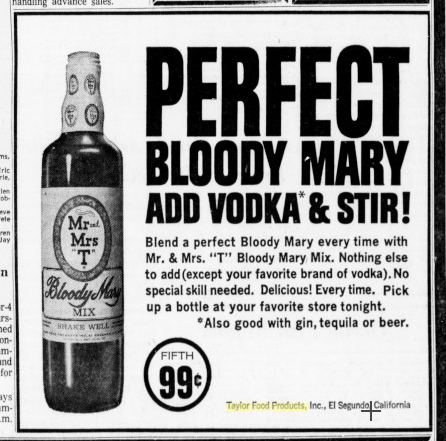
Newspaper ad, San Bernardino Sun, 1966.
As reported in the Los Angeles Times, “The first major [corporate] account for the mix was Host International, which operates restaurants and bars at Los Angeles International Airport. The first big break came when an American Airlines executive had a Bloody Mary at an airport bar and liked it so much he ordered Taylor’s mix to be served on American’s flights.” For airlines, because the drink was “too complicated to prepare without a ready-made mix,” Mr and Mrs T® provided the perfect solution for the jet set. (In 2018, United Airlines stopped serving tomato juice and only offered Mr & Mrs T® Bloody Mary Mix.)
The original Bloody Mary Mix was sold in pint-size glass bottles and the barbecue sauce and marinade and seafood cocktail sauces were all manufactured and distributed in 12-ounce bottles; however, airlines would need six-ounce cans for inflight use. Prior to the introduction of recyclable aluminum cans in the 1970s, steel tin cans were “still the most reliable way to pack your products for market.” The new line to support the airline business was installed by Can Lines Inc., a Gardenia company. By necessity and to save money, Taylor Food Products took a then somewhat novel approach and placed a can line and a glass line side-by-side in the same room supplied by a single feeder line. By economizing the company could remain in its 10,000 square foot facility in El Segundo, negating the need to move to a larger and more expensive space.
Looking back in 1967, Lee, serving as the company’s vice president and production manager said of the Bloody Mary Mix containers, “We knew what we wanted to do, but we didn’t know exactly how it was to be accomplished.” Turning to an expert they received technical assistance from Jack McMillan of the American Can Company. With the glass line for the 12 oz. barbeque sauce bottles already in place the Taylor’s added a second line for the Bloody Mary Mix that could churn out 120 cans per minute. From humble beginnings—at home the products were made in five-gallon batches—the sauces and mix were now created in one 600-gallon Lee Kettle and two 200-gallon kettles.
The ingredients, sourced from Hunt’s Foods (tomato sauce), Spice Products of Anaheim, H. J. Heinz (catsup), and Sunkist (lemon juice), among others, were combined in the large Lee Kettles and sent through stainless steel pipes into cans and bottles. With the aid of a Continental Can seamer the cans were filled from the bottom end with the heat purified mix, inverted, water cooled, and bundled in cartons of twenty-four. Distributers sold the product nationwide to grocery stores, restaurants, and hotels, and bars.
By January 1967, the American Tobacco Company in a move to diversify had acquired the James Beam Distilling Company and would acquire Mott apple products before “Tobacco” was dropped and in 1969 the company was rechristened American Brands.
Demand was tripling year-over-year and Taylor Food Products was producing 100,000 cases by 1967. As success on Shark Tank often proves it helps to be homemade, first to market, and with a strong identifiable product that serves a need.
Overcoming challenges

Fort Worth Star-Telegram, November 9, 1973
Challenges along the way included the laborious process of hand-making small batches with little financial gain; resistance to pricing for what was perceived as a can of “tomato juice,” although it was more than that; and grumblings from bartenders reluctant to use a canned product. Mr and Mrs “T”® promised and delivered “a consistent pour” and it was the consistent taste and ease of use, no preparation or ingredients needed, that grew sales at the same time as Americans began to eat out more frequently. Similarly, McDonalds would bring consistency to the American fast-food market for burgers, just as Starbucks would do for coffee in the 1990s.
Keeping competitors at bay led to at least one lawsuit. When the Empire Pretzel & Potato Chip Corporation filed an application in 1966 to register “Mister Tee’s” for their potato chips and corn type snack products, Taylor Food Products filed a lawsuit alleging that the trademark “sought to be registered is confusingly similar to its MR AND MRS T. and since the goods of the parties are closely related, the purchasing public will assume that the goods have a common origin.” It appears the lawsuit succeeded.
With a common trade name confusion may have been inevitable. When Long Beach Press-Telegram “Table Talk” columnist Tedd Thomey referred to his wife as “Mrs. T” in 1973 he was asked by friends if the Thomeys were connected with Mr. and Mrs. T products. Out of curiosity Thomey and his wife tried the Bloody Mary mix in question and declared it, “Darned good! It has 14 ingredients, including some spices that give it a pleasant sockeroo.” At the time, the company’s products included Sweet ‘n Sour Lemon Mix, Grenadine Syrup, and Bully-Hi. The latter, introduced in 1970, was a Beef Cocktail Mix that when combined with vodka would result in either a Bull Shot or a Bloody Bull, basically a Bloody Mary with beef bouillion. The Bull Shot, or Bullshot, is a Bloody Mary that swaps out the tomato juice for beef broth. The Taylor product was geared toward bartenders who did not tend to have beef broth behind the bar to mix the drink.
By 1983, the year Herb died, Taylor Food Products, employing 60 people and operating out of a 60,000 square foot facility in Compton, was ringing up $20 million in sales. The distiller Heublein ranked the Bloody Mary as the eighth most popular mixed drink in America. (Ironically, due to the overwhelming success of the Bloody Mary Mix the barbecue sauce that launched the company was dropped in 1982.)
The corporate headquarters moved to Chicago in August 1983, and Wayne A. Meland was named executive vice president and chief operating officer. Corporate-sponsored events included a “T” party in San Francisco where Mr. and Mrs. T cocktails went for one dollar. The City Celebration benefit at One Embarcadero, billed as “San Francisco’s Most Exotic Happy Hour Ever,” featured a contest for “The City’s best party-givers.” Rave reviews did not follow, “the floor was wet and slippery, the entertainment loud and the drinks on the weak side.”
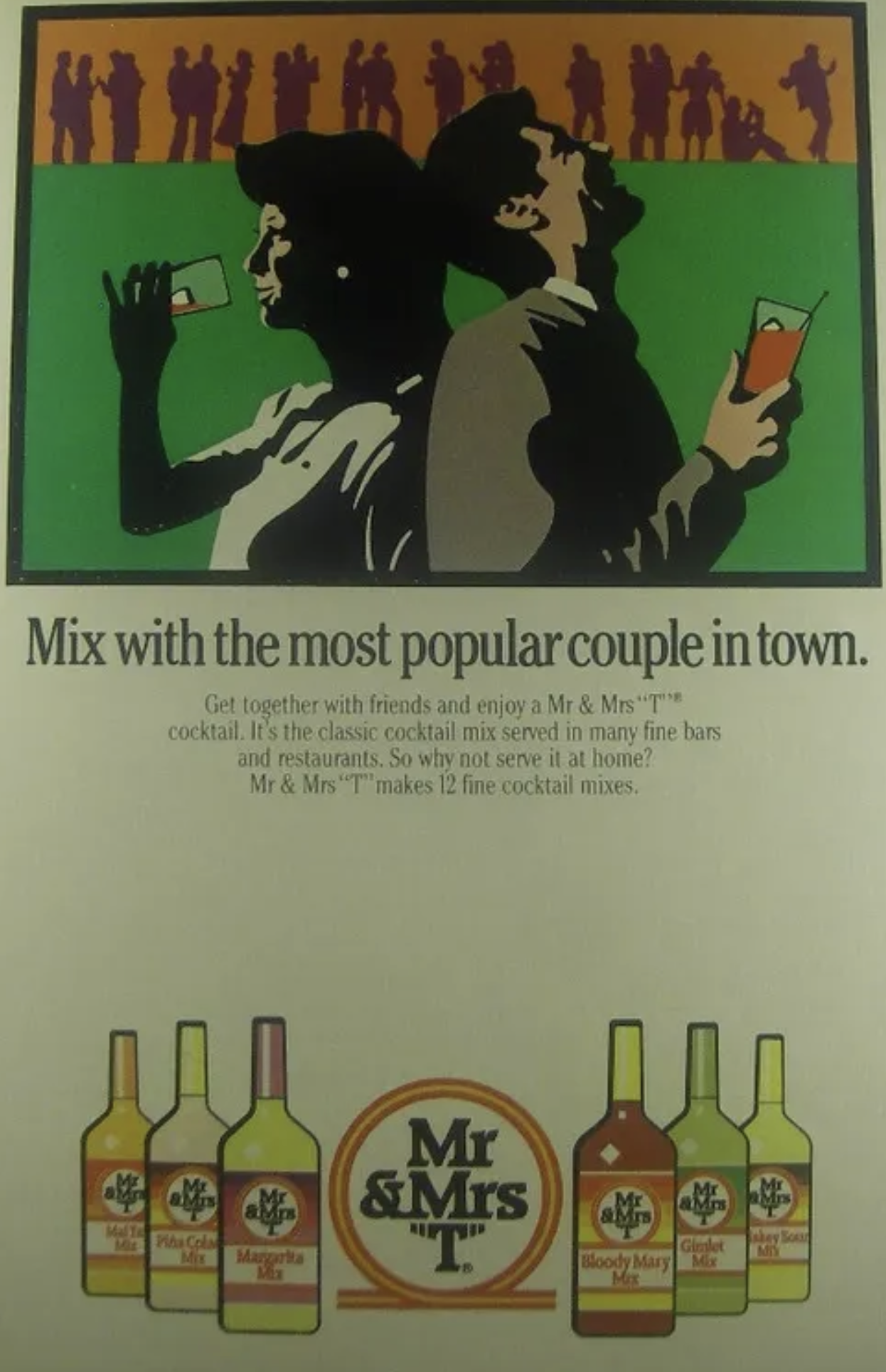
Ad campaign by Marsteller, circa 1985.
A year later Meland launched an aggressive $1 million ad campaign with a Chicago-based ad agency, Marsteller. The label and logo were redesigned, specifically focused on expanding the home and international markets. The typical customer was described generically as “a couple” with “a busy lifestyle” that likes “to relax and have parties.”
In the leisure market, smokers could light up with Mr & Mrs “T” matches, golfers could tee off with a ball depicting the company logo, and another Mr. T, that of television fame, appeared on Saturday Night Live! in a 1982 sketch spoofing the name of the Bloody Mary Mix. Watch it on You Tube!
Made from Scratch Taste
In December 1987, the Mr & Mrs T® brand was acquired by Cadbury Schweppes for $18 million from American Brands. The Mott’s USA division of that company, Mott’s Inc., operated as the only division within Cadbury Schweppes responsible for its own processing.

“Stylized” logo, 1993.
“Made from Scratch Taste,” a trademark of Mott’s LLP, became the tag line for Mr and Mrs T® non-alcoholic cocktail mixes in March 2009. The Mott-o is meant to denote traditional recipes and authentic ingredients in a perfect balance of sweet and tart.
With aims to continue to grow the brand, Mott’s introduced a Horseradish Bloody Mary Mix marketed to those who have always made the drink from scratch. It launched in February 2003.

New logo design trademarked in 2003.
Mr and Mrs T® continued to grow and thrive to become the top-selling brand of liquid cocktail mixers in the U.S. and a staple of bars, restaurants, and American homes. The “Made from Scratch Taste” product offerings include mixes for the Original Bloody Mary, Bold & Spicy Bloody Mary, Horseradish Bloody Mary, Mai Tai, Manhattan, Margarita, Old Fashioned, Piña Colada, Strawberry Daiquiri-Margarita, Sweet & Sour, Tom Collins, and Whiskey Sour.
The market share of the Mr & Mrs T® brand of Bloody Mary Mix was estimated at 30 percent in 1990 and 62 percent in 1997. In 1997, Tabasco Bloody Mary Mix was second in market share with 12 percent.
Based on the number of newspaper articles that mention Bloody Mary, thirst for the drink did grow greatly and peak during the 1990s when hotels and restaurants featured do-it-yourself Bloody Mary bars. Interest fell off drastically, again, gauged by printed articles, in the 2000s.
Interlude: An actor with a sense of humor and Vodka, the dog
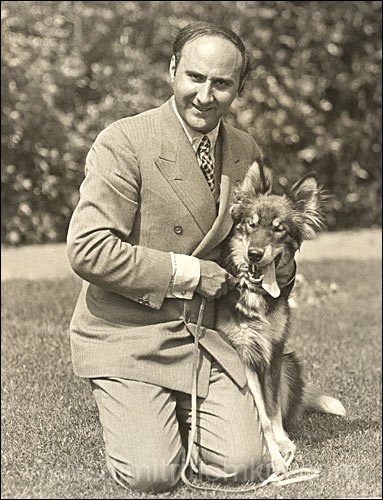
Dimitri Tiomkin with his dog, circa late 1930s
Dimitri Tiomkin was in Russia in the mid-1960s producing the film Tchaikovsky, for which he would also provide a music score, when a package from John Wayne arrived from the U.S. with a note, “Thought you might be needing this.” The gift was a bottle of vodka.
Tiomkin preferred vodka and when dining with director Alfred Hitchcock, the composer noted, “He has wine and I have vodka.”
Vodka, described as half husky and half wolf with an angelic disposition, lived with Dimitri Tiomkin and Albertina Rasch in their Central Park West apartment in New York in the early 1930s.
Years later in London in the 1970s, Dimitri and Olivia Tiomkin had two dogs, one named Vodka.
 Life Well Mixed: Keurig Dr Pepper
Life Well Mixed: Keurig Dr Pepper
Today, Keurig Dr Pepper produces and distributes the mixes, having acquired Mott’s in a 2018 merger. The beverages continue to be bottled under the authority of Mott’s LLP in Plano, Texas. There are now no less than four Bloody Mary Mixes to choose from: Bold & Spicy, Horseradish, Original, and Zesty (formerly Fiery) Pepper.
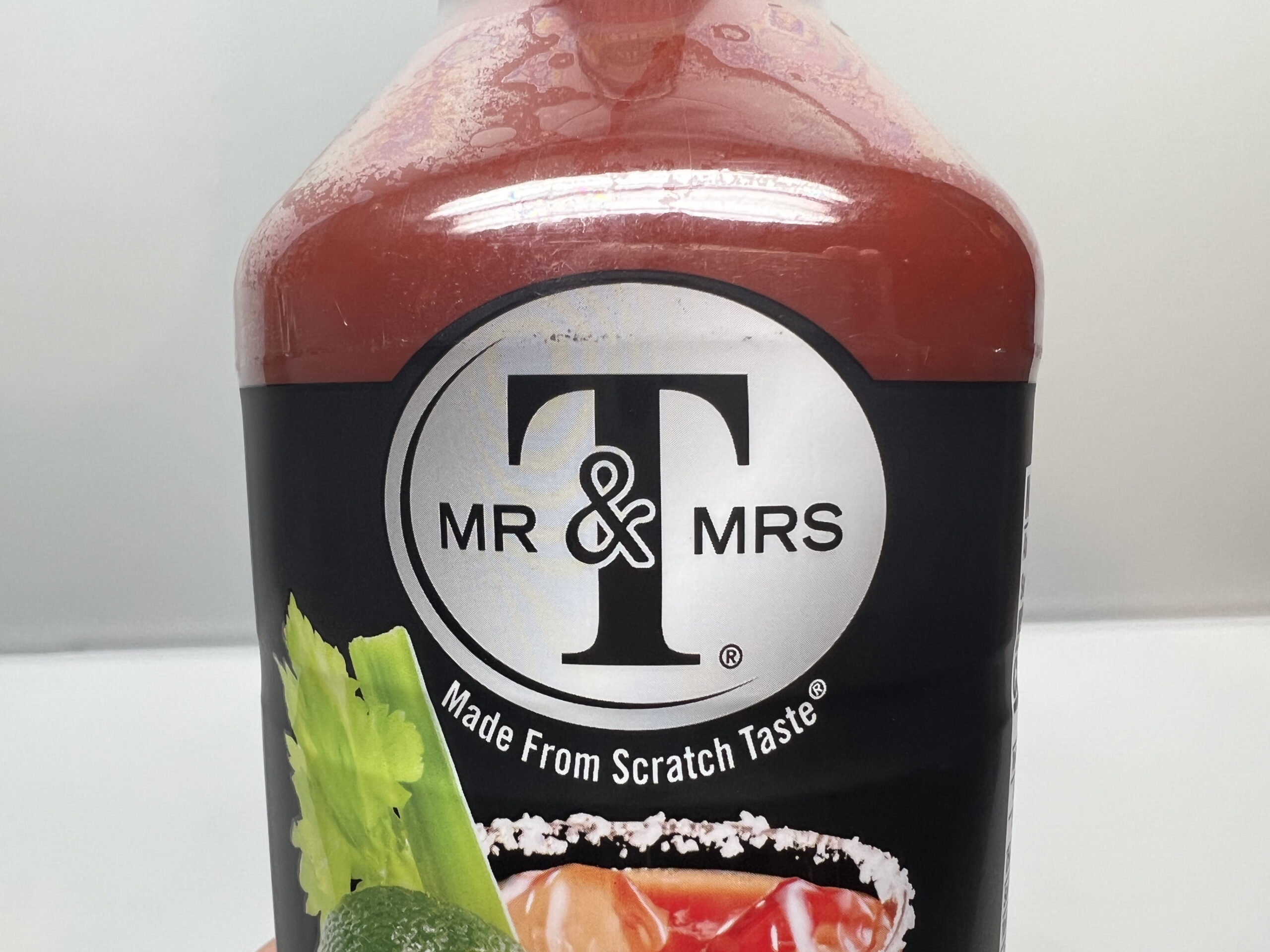 With more than two dozen listed ingredients, the Original Bloody Mary Mix is a fairly complex concoction consisting largely of water and tomato concentrate. (No concentrates were used in the original recipe, only pure tomato juice and catsup, and some beef fat.) On the acidic side are the concentrates of tomatoes and lemon juice, vinegar, and the weaker malic and citric acids. The sweet and savory tastes are from cane sugar and autolyzed yeast extract. The kick comes from Worcestershire sauce, cayenne pepper, and red chili pepper, with added tanginess from unnamed spices, paprika, and garlic powder. The flavor enhancers include hydrolyzed corn protein and dashes of salt, salt, salt (sea salt, salt, and more salt in the Worcestershire sauce). The five percent that is not fruit juice is what separates this mix from any other. The proprietary Worcestershire sauce, a fermented condiment, is made from a base of vinegar and flavored with molasses, garlic and onion powers, smoke flavor, and other seasonings. The three gums (acacia, guar, and cellulose) largely function as thickeners and stabilizers.
With more than two dozen listed ingredients, the Original Bloody Mary Mix is a fairly complex concoction consisting largely of water and tomato concentrate. (No concentrates were used in the original recipe, only pure tomato juice and catsup, and some beef fat.) On the acidic side are the concentrates of tomatoes and lemon juice, vinegar, and the weaker malic and citric acids. The sweet and savory tastes are from cane sugar and autolyzed yeast extract. The kick comes from Worcestershire sauce, cayenne pepper, and red chili pepper, with added tanginess from unnamed spices, paprika, and garlic powder. The flavor enhancers include hydrolyzed corn protein and dashes of salt, salt, salt (sea salt, salt, and more salt in the Worcestershire sauce). The five percent that is not fruit juice is what separates this mix from any other. The proprietary Worcestershire sauce, a fermented condiment, is made from a base of vinegar and flavored with molasses, garlic and onion powers, smoke flavor, and other seasonings. The three gums (acacia, guar, and cellulose) largely function as thickeners and stabilizers.
Keurig Dr Pepper has a portfolio of more than 125 owned, licensed and partner brands, with leadership across numerous beverage categories. Followers of investor Peter Lynch who tend to invest in the stock of products they consume might consider buying Keurig Dr Pepper (KDP). Evercore ISI strategist Julian Emanuel recently pointed out in Barron’s the stock appears in a screen “for healthcare and staples stocks in the Russell 1000 index that have underperformed the median stock in their sectors…even though their earnings per share are expected to grow faster than their sector’s.”
Prior to researching and writing this article, I had never had a Bloody Mary. My preferences in alcohol run to deep red table wine; dark craft beers, including stouts and porters; and amber or darker-hued liquor from brandy to bourbon and rum. I’m not a fan of tomato juice, except perhaps in V-8 juice, and distilled spirits that can be mistaken for water are among my least favorite; vodka ranks at the low end of hard liquor, only a bit higher than tequila.
My first Mr & Mrs T® Bloody Mary was quickly followed by a second. The tanginess and strength of the mix deftly delivers the alcoholic content. If I ever were to become a day drinker, I could get used to this.
Who needs vodka?
One can consume the drink without adding vodka. Unlike most other mixes, such as margarita mix, the virgin Bloody Mary can provide a “punch of flavor” and a pick-me-up all by itself. In fact, when the caviar company Romanoff International briefly entered the Bloody Mary mix market in the early 1990s with the dubious tag line, “Eat, drink, and meet Mary,” they estimated that around 15 percent of Bloody Mary mix purchases were consumed straight.
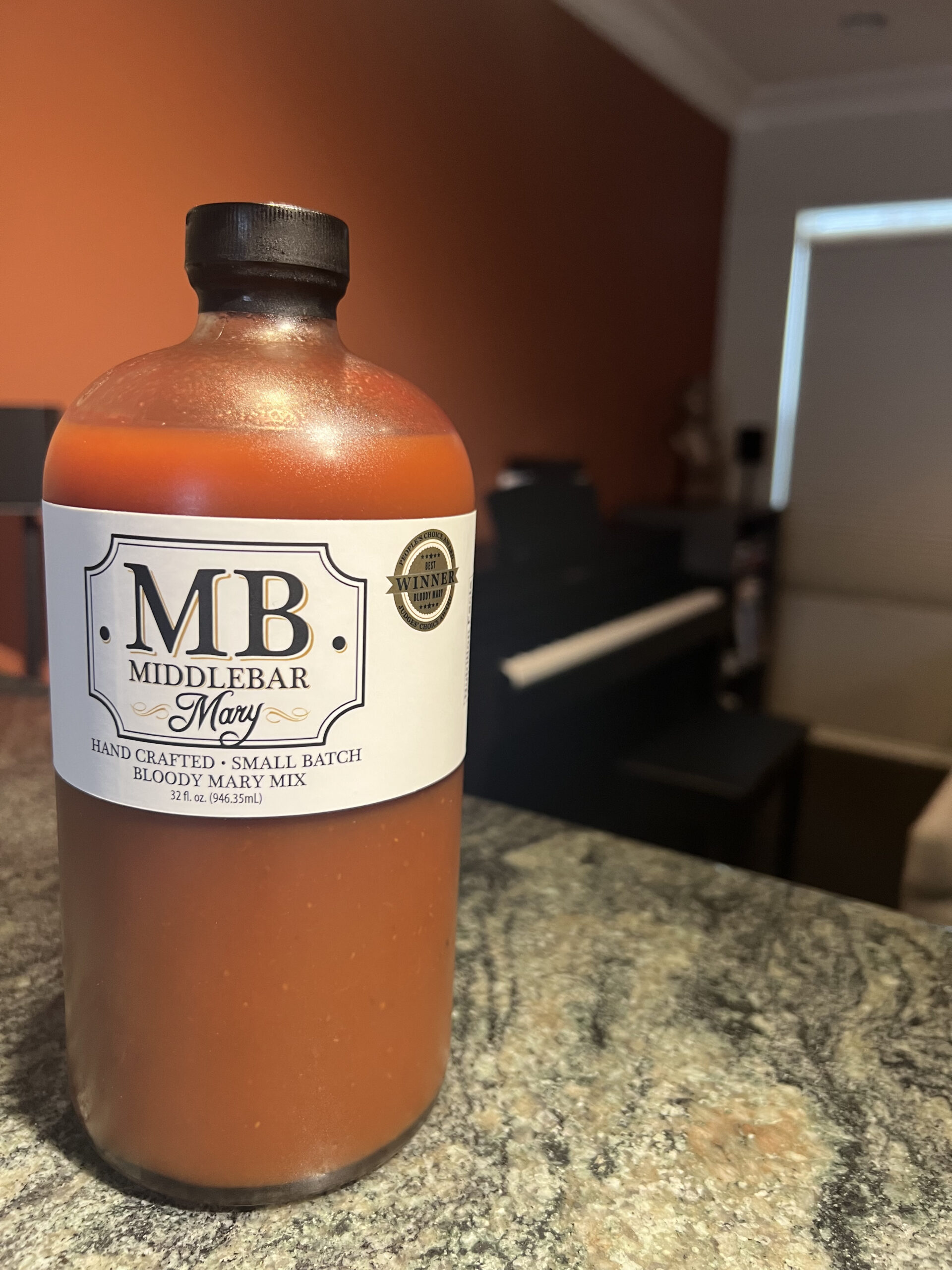 Case in point, at a recent lunch at Surfas Culinary District—the go-to supplier for chefs in Los Angeles, as seen on Top Chef, complete with Café and shady patio located in the West Adams district in the shadow of downtown—Middlebar happened to be offering virgin shots of their hand-crafted small batch award-winning Bloody Mary Mix, created by Corrie Scully and Renie Schoenkerman. Their story is not dissimilar to the Taylor’s, they expanded their local-made product from roots selling bottles at Los Angeles-area Farmer’s Markets into the grocery store and restaurant business. Middlebar Mary stimulates the senses and provides a delicious tingle with forward-fresh tomatoes perfectly blended with spices, tangy and zesty to the palate with no aftertaste. I purchased a 32-ounce bottle, the packaging allows the classic deep red color to show through, to enjoy at home. It is definitely a worthy contender in the marketplace.
Case in point, at a recent lunch at Surfas Culinary District—the go-to supplier for chefs in Los Angeles, as seen on Top Chef, complete with Café and shady patio located in the West Adams district in the shadow of downtown—Middlebar happened to be offering virgin shots of their hand-crafted small batch award-winning Bloody Mary Mix, created by Corrie Scully and Renie Schoenkerman. Their story is not dissimilar to the Taylor’s, they expanded their local-made product from roots selling bottles at Los Angeles-area Farmer’s Markets into the grocery store and restaurant business. Middlebar Mary stimulates the senses and provides a delicious tingle with forward-fresh tomatoes perfectly blended with spices, tangy and zesty to the palate with no aftertaste. I purchased a 32-ounce bottle, the packaging allows the classic deep red color to show through, to enjoy at home. It is definitely a worthy contender in the marketplace.
A sublime creation
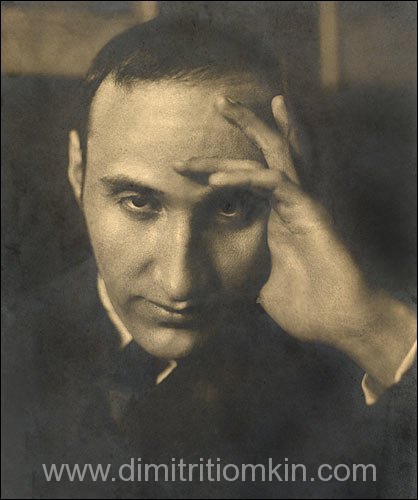
Dimitri Tiomkin portrait, circa mid-1920s
In closing, “in the opinion of vodka experts, the most sublime of all vodka creations is the Bloody Mary.”
Olivia Tiomkin recalls Dimitri speaking of the Taylor’s Bloody Mary Mix. The composer may have been among the first musicians in Hollywood to partake of the Taylor’s homemade barbecue sauce and the Bloody Mary Mix. For the latter, one would imagine Tiomkin added only the finest Russian vodka.
VISIT: Mr and Mrs T.com
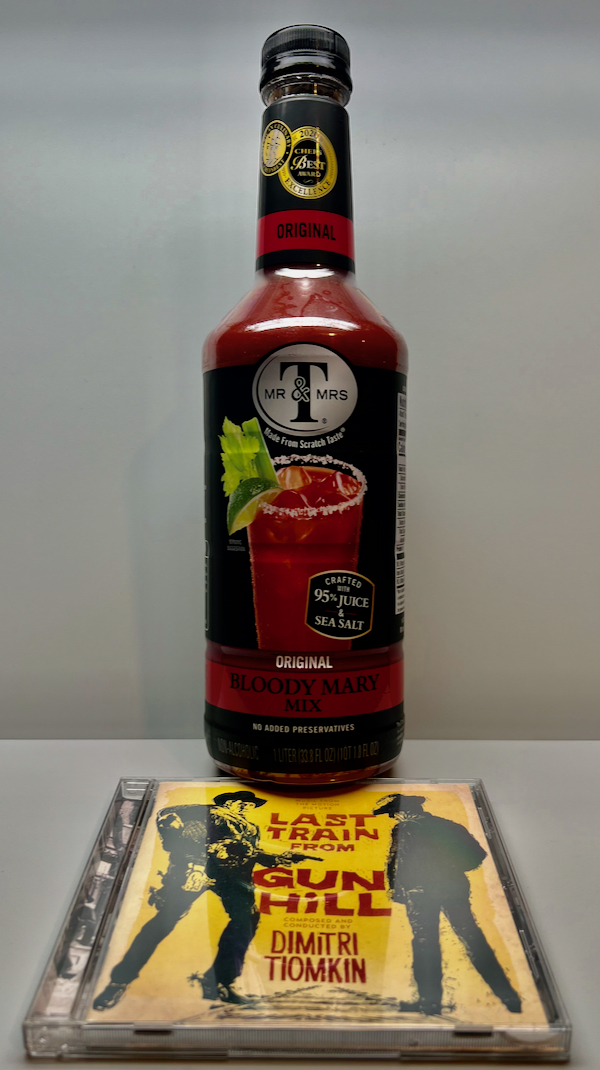
“Last Train from Gun Hill,” music composed by Dimitri Tiomkin, with orchestrations by Herb Taylor, film released in 1959; Mr & Mrs T® Original Bloody Mary Mix, created from a recipe by Herb and June Taylor, first sold circa 1960.
Posted July 4, 2023, last updated July 9, 2023.
Sources (for Part 1 and Part 2)
Herb Taylor and Herbert Taylor are common names making disambiguation challenging at times, for example, our Herb Talyor is not to be confused with Herbert Taylor the sound guy on Disney films, the Chicago trumpeter Herb Taylor, or the bass fiddle player in Reno, Nevada.
“The Inquest of Gofield,” Stockton Daily Evening Record, January 2, 1912.
“Young Mother Dies,” Stockton Daily Evening Record, March 23, 1914. Obituary of Florence Jennie Taylor.
“Moose Will Go to Jackson Soon: Fraternal Visit Will Mark First Public Appearance of the Stockton Moose Drum, Fife and Bugle Corps,” Stockton Independent, February 7, 1916.
Stockton Record Family Log, January 28, 1917. I was unable to access this edition, apparently an employee monthly newsletter, which according to the family contains a picture of Herb Taylor and biographical details.
“The Record Boys Saw the Show,” Stockton Evening and Sunday Record, March 11, 1919.
“Record Family’s Welcome Home to Its Service Men,” Stockton Evening and Sunday Record, May 7, 1919.
“The Record Carrier Boys Band—How and Why It Was Organized—The Conception of Manager A. A. Seaver, Stockton Evening and Sunday Record, October 21, 1919.
“Mrs. Stevenson Is Borne to Last Rest,” Stockton Daily Evening Record, April 15, 1920. Obituary for Ella J. Stevenson.
“Mineral Baths Scene of Jinks by Auto Men: Cars Follow Insignia in Big Parade Through Streets,” Stockton Independent, June 23, 1920.
“Modern Minstrel Show Will Open at Auditorium This Evening,” Stockton Independent, November 5, 1920.
“Dancing Arcade Event Is Fox Trot Contest,” Stockton Daily Evening Record, January 18, 1922.
Ads, “Tonite / Big Carnival Celebration” and “Grand Easter Ball,” Stockton Evening and Sunday Record, April 5 and 15, 1922.
“Sang’s Syncopators to Open Engagement Tomorrow,” Stockton Independent, April 8, 1922.
“Pageant Contest Interest Is Keen,” Stockton Daily Evening Record, June 2, 1922.
“Intoxication Is Alleged in the O’Dair Divorce,” Stockton Daily Evening Record, December 18, 1922.
“Radio Fans Demand Close-Up of St. Francis Orchestra,” Stockton Evening and Sunday Record, January 10, 1925.
Orpheum Circuit Vaudeville, display ad, January 26, 1925.
“Henry Halstead Orchestra Will Play in Pomona,” Pomona Progress Bulletin, September 4, 1925.
Inside Facts of Stage and Screen, January 11, 1930. News item on Taylor joining Lyman’s band.
“Ballet Producer and Composer Reach L.A.,” Los Angeles Daily News, January 16, 1930.
“Stars Swarm to See Rogue Song Premiere,” Los Angeles Record, January 18, 1930.
“Dancing in the Fore Court,” Los Angeles Record, January 23, 1930.
“Lyman Prepares Varied Program,” Los Angeles Evening Post-Record, September 30, 1930.
“Lyman Blocks Out ‘Just Imagine’ Program: Popular Orchestra Will Remain At Carthay With Novelty Film,” Los Angeles Evening Express, September 30, 1930.
“Moods of Jazz To Be Offered By Abe Lyman,” Los Angeles Daily News, October 1, 1930.
“Carthay Circle (Lyman’s Band),” Variety, November 26, 1930.
“Carthay Circle, L.A.” Variety, April 22, 1931.
“About New York,” by William Gaines, Ponca City, Oklahoma, March 2, 1932.
“Herb Taylor is out of the Abe Lyman organization,” Variety, February 6, 1934.
“Listening on the Bee Radio,” Fresno Bee, June 4, 1934.
“Radio Chatter,” Variety, June 12, 1934.
“Here and There,” Variety, July 31, 1934.
“Radio Chatter: San Francisco,” Variety, August 14, 1934.
“Radio-Reviews,” Variety, August 25, 1934.
“Saint Louis County Little Theatre Combing County for Talent,” Webster News-Times, October 29, 1937. May be unrelated to our Herb Taylor.
“Musicians Greet Orchestra Head at Banquet,” Reno Evening Gazette, November 8, 1937. May be unrelated to our Herb Taylor.
“Chico Marx Will Become Orchestra Leader,” Los Angeles Times, October 5, 1940.
“Maestro Chico Marx,” Variety, October 9, 1940.
“Out of the Horns’ Mouth,” Variety, January 14, 1949. On signing Herb Taylor for Champion.
Penny Singleton ad. Hollywood Reporter, January 19, 1950.
“Singleton Set For TV Show Build Up.” Hollywood Reporter, September 1, 1950.
“Services Set for Mrs. Margaret Aratta,” Stockton Evening and Sunday Record, September 28, 1951. Mother of Viola May Golfield (Taylor).
“Masterful Score for ‘Cyrano de Bergerac,’” Musical Express, August 3, 1954.
Official Gazette of the United States Patent Office, 1954, p. 734. Taylor Food Hobbies.
“Couple Will Introduce New Sauce,” Bakersfield Californian, October 31, 1956.
“The Vodka Revolution: Bloody Mary, Screwdriver and Moscow Mule Are Sweeping the Country,” Boston Sunday Globe, December 2, 1956.
[print ad], Van Nuys News, June 18, 1959, p. 57.
“Tomato Juice Party Drink,” Green Bay Press-Gazette, August 6, 1959.
“Smirnoff Vodka” [display ad], North Bay Nugget, December 23, 1960.
“Ian Fleming’s Greatest Thriller THUNDERBALL,” Chapter 15, reprinted from the novel by permission, The Record American, February 9, 1962.
Raley’s Drug Center [print ad], Reno Gazette-Journal, April 4, 1962. Earliest found public record of the Taylor’s Bloody Mary Mix in the marketplace.
“Gourmet Food Industry One Of The Largest,” Valley Morning Star, May 19, 1964.
“On the Town: Bloody Mary,” by Charles McHarry, Daily News, August 20, 1964. Rife with origin stories.
“Buys Food Interest,” Pittsburgh Progress-Index, October 30, 1964.
“People at Work,” by Herb Stoy, Stockton Evening and Sunday Record, October 2, 1967. On Herb and June (Viola) Taylor.
“Bloody Mary Mix by Mr. and Mrs. ‘T’ Produced in Harmony,” by John Urbanek, Canner/Packer, Vol. 136, No. 4, April 1967.
“Favorite Things / Dimitri Tiomkin,” by Yvonne Thomas, Evening Standard, March 25, 1970.
Official Gazette of the United States Patent Office: Trademarks, 1972.
“Tiomkin’s Tchaikovsky,” Sunday Democrat and Chronicle, February 20, 1972.
“Table Talk,” by Tedd Thomey, Long Beach Press-Telegram, May 4, 1973.
“Be Famous for Your Bloody Marys” [advertisement], Fort Worth Star-Telegram, November 9, 1973, p. 8.
““De Gustibus: Making Bloody Mary’s From Scratch,” by Craig Claiborne, New York Times, November 15, 1976.
“De Gustibus: Bloody Mary As It Should Be — and as It Rarely Is,” by Mimi Sheraton, New York Times, November 22, 1980.
“Nation’s Drinkers Are High on Bloody Marys, Thanks to Compton Firm,” by David Einstein, Los Angeles Times, July 10, 1983.
“Taylor Taps Marsteller,” Chicago Tribune, August 1, 1983.
“Nation’s Drinkers High on Popular Bloody Mary Mix,” by David Einstein, Los Angeles Times, August 25, 1983.
“Four public parties at once,” San Francisco Examiner, November 9, 1983.
“Winners’ party secret: good people,” San Francisco Examiner, November 11, 1983.
“Cocktail-mix company launches as campaign to stay tops in market,” Arizona Republic, March 5, 1984.
“Coconut Flavors Cocktails, Cakes,” The Tennessean, July 26, 1984.
“Cadbury buy,” Daily Telegraph, December 17, 1987.
“On marketing: Alcohol optional, says mary maker,” by George Lazarus, Chicago Tribune, July 13, 1990.
TV’s Biggest Hits: The Story of Television Themes from Dragnet to Friends, by Jon Burlingame, Schirmer Books, 1996.
“The Easy Way Out for Bloody Marys,” by Florence Fabricant, New York Times, August 8, 1997.
Hugo Friedhofer: The Best Years of His Life, edited by Linda Danly, Scarecrow Press, 1999.
Put Your Dreams Away: A Frank Sinatra Discography by Luiz Carlo Nascimento Silva, Greenwood, 2000.
“Spirits: The Essential Bloody Mary,” by Katie Aberbach, News Journal, March 30, 2011.
“Mr. and Mrs. T’s Well-Seasoned Jazz History,” Jazz Lives, January 8, 2015. Interview with Lee and Patsy Ann Taylor, Napa, California, August 26, 2014.
Barron’s, May 8, 2023.
Music for Prime Time: A History of American Television Themes and Scoring, by Jon Burlingame, Oxford University Press, 2023.
Ben Black: California’s King of Rhythm
“Celebrating the History and Achievements of the American Society of Music Arrangers and Composers” by Jeannie Gayle Pool
“Bloody Mary: History and Recipes to Create It at Its Best,” pomi.us.com

